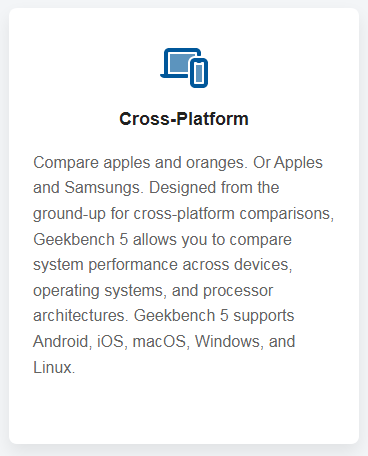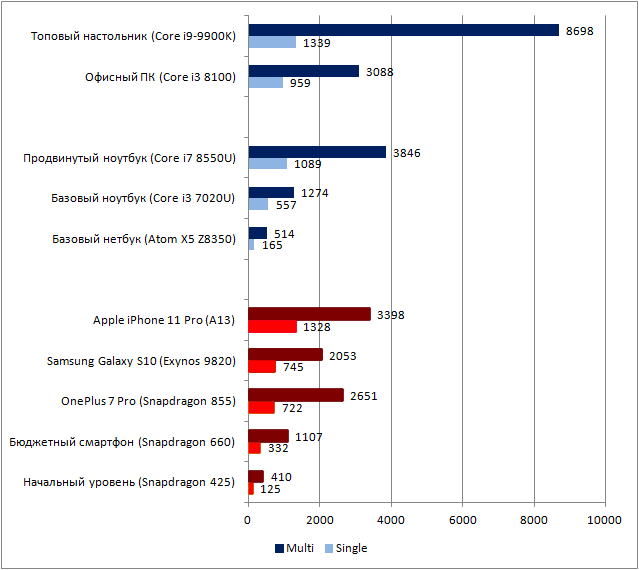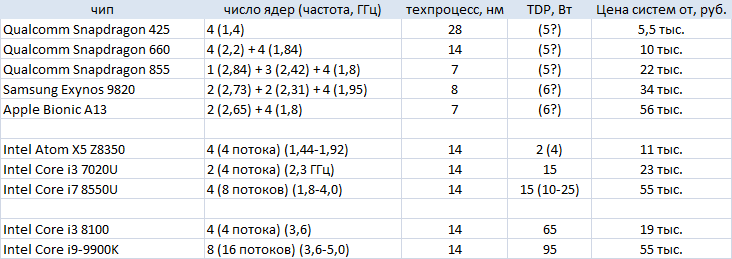After the release of the iPhone 11 with the SoC Bionic A13, there was once again a desire to compare its performance with a PC. A couple of years ago, Apple chips already outperformed the middle segment of laptops. And since there is practically no progress in productivity there, the new pocket gadget should now bypass the entire laptop fraternity and thoroughly “bite” desktop systems.

Passed in many ways. I bit it. Details under the cut.
Studying the opinions of who is faster (smartphones or laptops), the most common was the option: “How can a smartphone over 60 thousand be slower than a PC that is cheaper?” True, these opinions were not expressed on Habré. But technically savvy people, on the contrary, asked, how can a baby with a TDP of 3-5 W get around monsters with a TDP of 65 W or more, despite the fact that they are produced using similar technological processes?
Two different camps formed. I myself, being in the first VO a systems engineer, belong to the second. And I have an answer to the question about watts. But let's get to the point.
Which line will we measure
We will compare performance in the Geekbench 5 cross-platform test, which emulates the operation of real user tasks such as archiving, encryption. How legitimate it is to compare different platforms in it is a good question. Lift it a little lower. And now I’ll just say that the creators of the test are pushing it hard:

I use this test periodically. But the results for this post were taken from the official charts. In them, the creators put the averaged values from what gets into their database from users. Most often, such results are slightly underestimated, because users are not professional testers. During the test, some software may work for them, or the power saving mode is turned on. However, we do not care. The extreme lower values there and so are surely discarded. In addition, I do not have the goal of obtaining precision data. It is enough to outline a certain general picture.
Test results

First, Apple is cool, and over the past couple of years, it has widened the gap between Qualcomm and Samsung with their licensed and doped armies.
The second - the performance level of top-end smartphones in office and consumer tasks equaled advanced laptops and good office PCs (see reservations below).
Third is single-core performance. It is she who is responsible for the responsiveness of the interface and the speed of the applications, the bulk of which are poorly adapted to parallelization.
Who is who on the chart
Now let's look at the experimental interior. For convenience, I collected everything in one tablet.

If you combine this data with the performance diagram, it is clear that the limited thermal package does not allow all cores of mobile chips to be threshed to the fullest. Additional restrictions are introduced by the big.LITTLE architecture, within which the simultaneous operation of a high-performance cluster in a chip and energy-efficient is not always possible.
Is it possible to compare different architectures?
A full comparison of processor architectures is extremely difficult, and I have no idea how to correctly do this. ARM belongs to the RISC type, and x86 to the CISC. Due to fewer instructions and fewer blocks, the ARM chip must execute individual instructions faster and more energy efficient. But as soon as it comes to performing complex functions, for which x86 has prefabricated hardware blocks and command sets, ARM will smoke aside. But this is in theory.
And there are different OSes, different compilers. And it seems to me that the Geekbench developers scored a little on all this, simplifying everything to monitoring the system’s execution of some typical tasks, for example, decoding jpg or building cached web pages. At the same time, they tried to optimize the code for these tasks for each system separately.
As a result, the happy owner of the latest iPhone can proudly say that his smart is able to open photos from the gallery just as quickly as the top five-gig "stove" from Intel. But Geekbench no longer allows making more serious statements. However, for most everyday situations this is quite enough.
More details on their tests can be found here in this
pdf .
Why do these comparisons?
Three years ago I was visited by the thought that with the growth of mobile chip performance, they could encroach on the segment of low-cost netbooks, a third of the price of which, at times, is Microsoft's OS. Given the fact that Google distributes its OS for free, and for the addition of Google Play services and others you only need to pay $ 1 from the device, the idea of capturing the lower segment seemed quite realistic.
However, Qualcomm marketers took a different path and for the last couple of years they have been trying to surprise the world with systems for $ 1000 in which their top-end chips get along with Windows 10 ...
Chart Links
If you are interested in the averaged results of other systems, you can use the Hikbencha online database. Here are direct links to automatically updated charts for
Android ,
iOS, and
PC . In the
search, you can drive in any keywords (models of chips, smartphones) and see the results obtained by other users for these devices. The only thing is that you will have to filter inappropriate options yourself.
PS and yes, owners of top-end smartphones can be proud that they carry a thing in their pocket more powerful than most modern laptops. At least if you compare them for work in everyday applications.